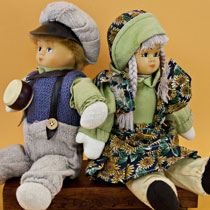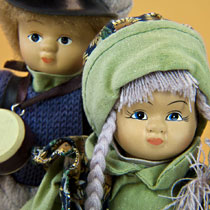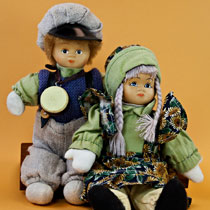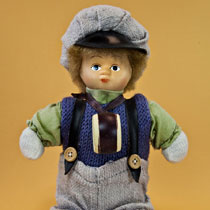Description of Figure/Doll
Norwegian boy and girl dolls who are sitting (back to back) on a block of wood. Both bodies are made by stuffing material, and the heads are ceramic. The boy is wearing a knit vest, pants with suspenders, and a hat. He has a hand drum. The girl is wearing a print jumper, green blouse, and leggings. She has a matching hat.
Link to higher resolution images at ClipPix
Norway
Location: Norway
Capital: Oslo
Main language: Norwegian
Currency: Norwegian, Krone
Figure/Doll
Construction: cloth, ceramic, yarn
Height in Centimeters: 16
Height in Inches: 6
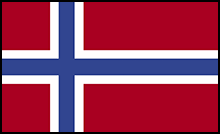
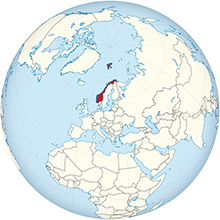
Folktales under the Northern Lights: Why the Bear is Stumpy-Tailed
Reading Level: 5.30
How would you like to live in a place where it is dark all day and all night for over two months every winter? Lucas and Frida (9 year old twins) live in Longyearbyen, a town in Svalbard, Norway. Svalbard is a group of islands north of mainland Norway. It is close to Greenland, Russia and the North Pole. It is so far north that it is considered “high arctic.”
During the polar winters (when there is no sun), Lucas and Frida play games inside most of the time. Of course, they also have to go to school too – even though it is dark. In the winter, the temperature is below freezing every day, and children must wear very heavy coats.
Since Svalbard is so close to the North Pole, it is not uncommon to see polar bears, arctic foxes and reindeer in this culture. These are some of the few animals that can survive the harsh winters on land. Near the sea, you might see whales, walrus, and seals in the water.
There is one other sight that is unique to Longyearbyen and similar areas. Because Svalbard is so close to the North Pole, it is one of the best places to see the wonder of the Aurora Borealis (Northern Lights). In fact, tourists fly to Svalbard from all over the world to see the winter sky light up in beautiful red, green, and blue flashes.
How, you might wonder, can the sky light up if the sun doesn’t shine? It’s because the north and south poles act like magnets to attract the small particles that are continually released by the sun. When these particles mix with the cold air around the poles, the particles glow, and look like curtains of lights in red, blue, green, and violet. This phenomena is called the Northern Lights or Aurora Borealis.
For the twins, seeing the Northern Lights on a winter night is a special treat. It’s even better when their parents tell then a Norwegian folktale while they watch the “fireworks.” One of their favorite folktales is called “Why the Bear is Stumpy-Tailed.” The story is about a bear and an arctic fox. It goes like this:
One day the Bear met the Fox, who came slinking along with a string of fish he had stolen.
“Whence did you get those from? asked the Bear.
“Oh! I’ve been out fishing and caught them”, said the
Fox.
So the Bear had a mind to learn to fish too, and bade the Fox tell him how he was to set about it.
“Oh! it’s an easy craft for you”, answered the Fox, “and soon learnt. You’ve only got to go upon the ice, and cut a hole and stick your tail down into it; and so you must go on holding it there as long as you can. You’re not to mind if your tail smarts a little; that’s when the fish bite. The longer you hold it there the more fish you’ll get; and then all at once out with it, with a cross pull sideways, and with a strong pull too.”
Yes; the Bear did as the Fox had said, and held his tail a long, long time down in the hole, till it was fast frozen in. Then he pulled it out with a cross pull, and it snapped short off. That’s why bears go about with stumpy tails til this very day.
Folktale by by P.C. Asbjornsen and J. Moe

